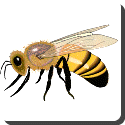 Bees — Bees are flying insects closely related to wasps and ants. Bees are a monophyletic lineage within the superfamily Apoidea, presently classified by the unranked taxon name Anthophila. There are slightly fewer than 20,000 known species of bee, in 9 recognized families, though many are undescribed and the actual number is probably higher. They are found on every continent except Antarctica, in every habitat on the planet that contains flowering dicotyledons.
Bees — Bees are flying insects closely related to wasps and ants. Bees are a monophyletic lineage within the superfamily Apoidea, presently classified by the unranked taxon name Anthophila. There are slightly fewer than 20,000 known species of bee, in 9 recognized families, though many are undescribed and the actual number is probably higher. They are found on every continent except Antarctica, in every habitat on the planet that contains flowering dicotyledons.
Bees are adapted for feeding on nectar and pollen, the former primarily as an energy source, and the latter primarily for protein and other nutrients. Most pollen is used as food for larvae.
Bees have a long proboscis (a complex “tongue”) that enables them to obtain the nectar from flowers. They have antennae almost universally made up of thirteen segments in males and twelve in females, as is typical for the superfamily. Bees all have two pairs of wings, the hind pair being the smaller of the two; in a very few species, one sex or caste has relatively short wings that make flight difficult or impossible, but none are wingless.
The smallest bee is the dwarf bee (Trigona minima), about 2.1 mm (5/64”) long. The largest bee in the world is Megachile pluto, which can grow to a size of 39 mm (1.5”). Member of the family Halictidae, or sweat bees, are the most common type of bee in the Northern Hemisphere, though they are small and often mistaken for wasps or flies.
The best-known bee species is the Western honey bee, which, as its name suggests, produces honey, as do a few other types of bee. Human management of this species is known as beekeeping or apiculture.
Bees play an important role in pollinating flowering plants, and are the major type of pollinators in ecosystems that contain flowering plants. Bees may focus on gathering nectar or on gathering pollen, depending on their greater need at the time, especially in social species. Bees gathering nectar may accomplish pollination, but bees that are deliberately gathering pollen are more efficient pollinators. It is estimated that one third of the human food supply depends on insect pollination, most of this accomplished by bees.
Bees may be solitary or may live in various types of communities. The most advanced of these are eusocial colonies found among the honey bees, bumblebees, and stingless bees. Sociality, of several different types, is believed to have evolved separately many times within the bees.
In some species, groups of cohabiting females may be sisters, and if there is a division of labor within the group, then they are considered semisocial.
If, in addition to a division of labor, the group consists of a mother and her daughters, then the group is called eusocial. The mother is considered the “queen” and the daughters are “workers”. These castes may be purely behavioral alternatives, in which case the system is considered “primitively eusocial” (similar to many paper wasps), and if the castes are morphologically discrete, then the system is “highly eusocial”.
There are many more species of primitively eusocial bees than highly eusocial bees, but they have rarely been studied. The biology of most such species is almost completely unknown. The vast majority are in the family Halictidae, or “sweat bees”. Colonies are typically small, with a dozen or fewer workers, on average. The only physical difference between queens and workers is average size, if they differ at all. Most species have a single season colony cycle, even in the tropics, and only mated females (future queens, or “gynes”) hibernate (called diapause). A few species have long active seasons and attain colony sizes in the hundreds. The orchid bees include a number of primitively eusocial species with similar biology. Certain species of allodapine bees (relatives of carpenter bees) also have primitively eusocial colonies, with unusual levels of interaction between the adult bees and the developing brood. This is “progressive provisioning”; a larva’s food is supplied gradually as it develops. This system is also seen in honey bees and some bumblebees.
 Kids Portal For Parents India Kids Network
Kids Portal For Parents India Kids Network
